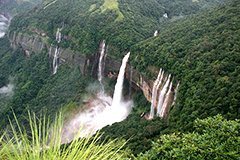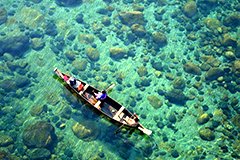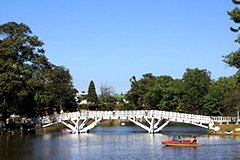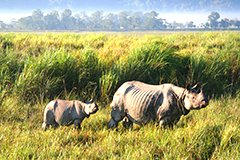2 States
08 Nights/09 Days Tour
Cherrapunjee-2, Shillong-3, Kaziranga-2, Guwahati-1
2 States
08 Nights/09 Days
Cherrapunjee-2, Shillong-3, Kaziranga-2, Guwahati-1
Day 1
Guwahati>>Cherrapunjee (5 hrs, 150 kms)

Pickup from Guwahat airport/ rly station & transfer to Cherrapunjee, which experience the 2nd heaviest rainfall in the world. Cherapunjee is also famous for the beautiful landscape. Cherrapunji, currently the historical name Sohra is more commonly used; alternative spellings are Cherrapunjee and Charrapunji), is a subdivisional town in the East Khasi Hills district in the Indian state of Meghalaya. It is credited as being the wettest place on Earth. Check in at hotel, overnight stay at Cherrapunjee.
Day 2
Cherrapunjee



After breakfast, proceed to Cherrapunjee sightseeing, scenic circular route covering:
- Mawsmai caves, situated around 6 kms from Cherrapunjee, these limestone caves have the distinction of being the only caves in Meghalaya that are lit enough to enable people to enjoy the natural formations inside. Though the caves are long, only a distance of 150 meters is open for tourists, while the rest is closed. The stalactites and stalagmites in the caves come in innumerable forms, shapes and sizes. This magnificent natural wonder has been created by years of natural abrasion and flowing underground water.
- Seven Sisters Fall, plunging down aheight of 1,035 ft, theNohsngithiang Fall is the fourth highest waterfall in India. This fall is located a few kilometres from Cherrapunjee. The fall derives its name from the seven streams that flow down the plateau. This waterfall is also known as Seven Sister Fall or Mawsmai Fall, the latter being the name of the village – a must see during the monsoons, when the streams are inundated with water and flow down rapidly forming a perennial rainbow.
- Nohkalikai Fall
- Dainthlen Fall
- The Living Root bridges(Umkar Root Bridge) are made from the roots of the Ficus elastica tree, which produces a series of secondary roots that are perched atop huge boulders along the streams or the riverbanks to form bridges.
The living root bridges, some of which are over a hundred feet long, take ten to fifteen years to become fully functional, but they’re extraordinarily strong – strong enough that some of them can support the weight of fifty or more people at a time. The bridges are alive and still growing and gain strength over time.
Back to the hotel by evening. Overnight stay at Cherrapunjee.
Day 3
Cherrapunjee >> Dawki >> Mawlynnong >>Shillong



After breakfast drive to Dawki, The small border town of Dawki in the West Jaintia Hills has the famous river Umngot which is a major tourist destination in Meghalaya. Dawki lies between India and Bangladesh and is the trade hub between the two countries. This small city is also famous for its famous Umngot river and a beautiful bridge.
People flock to the city to enjoy a boat ride in the Umngot river, and view of the nearby sights. During the spring season the tourist activities can be widely seen. A boat riding competition is hosted. The cold water, beautiful suspension brides and the surrounding greenery make it a worth visit.
BOATING CHARGES ON DIRECT PAYMENT AT DAWKI RIVER
Onwards to Mawlennlyong– said to be the cleanest village in Asia. Visit the sky view point- a maze of bamboo pathways which takes you above the tree tops to get a clear view of the Bangladesh plains. Mawlynnong is a village in the East Khasi Hills district of the Meghalaya state, India. It is famous for its cleanliness and natural attraction. Mawlynnong was awarded the prestigious tag of ‘Cleanest Village in Asia’ in 2003 by Discover India Magazine. Evening, proceed to Shillong, overnight stay at Shillong. Shillong, this is the capital and hill station of Meghalaya, also known as “The Abode of Clouds”, one of the smallest states in India. It is the headquarters of the East Khasi Hills district and is situated at an average altitude of 4,908 feet (1,496 m) above sea level, with the highest point being Shillong Peak at 6,449 feet (1,966 m). Shillong is the 330th most populous city in India with population of 143,007 according to the 2011 census. It is said that the rolling hills around the town reminded the European settlers of Scotland. Hence, they would also refer to it as the “Scotland of the East”.
Day 4
Shillong



Local sightseeing in and around Shillong – DBCIC, The Don Bosco Museum of Indigenous Cultures at DBCIC (Don Bosco Centre for Indigenous Cultures) is Asia’s largest Museum of Indigenous Cultures of its kind. In it the visitor can have an overview of the whole of North East India. Rising into Shillong’s skyline the Museum is a seven storey building with 17 well laid out Galleries of international standard containing artefacts, paintings, fiberglass figures – all a feast to the eyes and a source of knowledge. The topmost Gallery is where the visitors can relax and enjoy some of the rare dances of the North East. The Museum is indeed a surprise to visitors both from India and from abroad. Its best publicity are the visitors themselves who come to see it. Wards Lake, One of the most popular attractions of Shillong, Ward’s lake is a must-visit place when in this pristine north-eastern city. Also known as Pollock’s Lake, this artificial water body is encircled by an extensive lush garden and lies in the middle of the city. Take a walk around this horse-shoe shaped lake on the cobble-stone path or simply admire the colorful floral beds in the garden. It is equally popular amidst locals, family vacationers and honeymooning couples, as a picnic spot. Don Bosco Church, Police Bazaar for shopping. Overnight in Shillong.
Day 5
Shillong>> Mawsynram >>Shillong



After breakfast drive to Mawsynram which is a village in the East Khasi Hills district of Meghalaya state in north-eastern India, 65 kilometres from Shillong. It is reportedly the wettest place on Earth, with an average annual rainfall of 11,872 millimetres (467.4 in). Visit the Shivling inside the cave. Back to hotel by evening & overnight stay at Shillong.
Day 6
Shillong>> Kaziranga (8 hrs, 280 kms)



Morning after breakfast depart for Kaziranga National park– a world heritage site, the park hosts two-thirds of the world’s Great One-horned rhinoceros. Kaziranga also boasts the highest density of tigers among the protected areas in the world and was declared a Tiger Reserve in 2006. Though sighting of tigers are difficult because of the tall grasses that provide excellent camouflage, their presence can be felt everywhere by way of pug marks, kills and territorial markings. The park is home to large breeding populations of elephants, wild water buffalo and swamp deer. Arrive at hotel. Overnight stay at Kazir anga.
Day 7
Kaziranga National Park



Early morning at 5am, do the Elephant Safari for an hour. Back to the resort/hotel for breakfast. After breakfast do Jeep Safari to the Central Range of Kaziranga National Park. Overnight stay at Kaziranga.
Day 8
Kaziranga >>Guwahati (5 hrs, 240 kms)



After breakfast, transfer to Guwahati ; Pragjyotishpura in ancient Assam, is the largest city of Assam, a major riverine port city and one of the fastest growing cities in India, situated in the South Bank of river Brahmaputra . The ancient cities of Pragjyotishpura and Durjaya (North Guwahati) were the capitals of the ancient state of Kamarupa under the Varman and Pala dynasties. Many ancient Hindu temples are in the city, giving it the name “City of Temples”. Dispur, the capital of Assam, is in the circuit city region located within Guwahati and is the seat of the Government of Assam. Afternoon, The Kamakhya Temple; also Kamrup-Kamakhya is a Hindu temple dedicated to the mother goddess Kamakhya. It is one of the oldest of the 51 Shakti Pithas. Situated on the Nilachal Hill in western part of Guwahati city in Assam, India, it is the main temple in a complex of individual temples dedicated to the ten Mahavidyas: Kali, Tara, Sodashi, Bhuvaneshwari, Bhairavi, Chhinnamasta, Dhumavati, Bagalamukhi, Matangi and Kamala. Among these, Tripurasundari, Matangi and Kamala reside inside the main temple whereas the other seven reside in individual temples. It is an important pilgrimage destination for general Hindu and especially for Tantric worshipers. & Fancy Bazaar. Overnight stay at Guwahati.
Day 9
Guwahati >> Ghy Apt/Rly Stn drop



After breakfast, depart for Guwahati airport/railway station for onward destination.
*** Tour End ***

